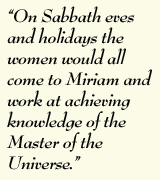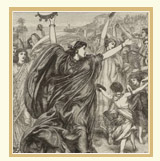Miriam the Teacher
Miriam’s spontaneous outburst of song allows readers to cast her in the role of prayer leader. However, this isolated episode was expanded by Rabbi Moshe Zvi Nerya who lauds Miriam’s role as a teacher par excellence. [1]“Kirvat Michanech l’Talmidav“, Techumin 16 1996, p.8 also “Hashaah haachat shel Miriam” in Al Mishnenot Haroim:Iyyunim b’darkam ubpoalum shel roai Yisrael, (Jerusalem, 1999). Rabbi Nerya discusses that the rabbinic vindication of the righteous women of the Exodus. They, according to tradition were not involved in either of the two fateful and fatal sins of the generation of the desert; the sin of the golden calf and the sin of the spies. [2]Midrash Tanhuma Pinchas 7 Vatikravna bnot Zelophad…vgidru hanashim. This contention is perplexing. The prophet Micah (6:4) points to three leaders who took the people out of Egypt, Moses, Aaron, and Miriam. Targum Jonathan elaborates:
For I have brought you up from the land of Egypt, redeemed you from the house of bondage, and sent before you Moshe to teach the law, Aaron to atone for the nation and Miriam to teach the women.
(Targum Jonathan Micah 6:4)
Moses was a man of God who with utmost devotion taught the people of Israel for forty years. Aaron, his brother was a man of peace and truth, dedicated to servicing the entire congregation of the Lord. How was it that they, according to the Rabbis, were unable to prevent the Israelite men from sinning, while the women did not falter? Rabbi Nerya’s answer is that Miriam danced with the women. She did not remain aloof – she got down with the people and danced together with her sisters. This rendered an indelible imprint upon their religious psyches and endowed the Israelite women with steadfast moral resolve. Earlier sources, as well, give Miriam credit for the electrifying effect she had on others. Consider the following passage in the Zohar:
All of the righteous women of that generation used to come to Miriam at those times. They would rise up like a pillar of smoke in the desert. That day was called the day of joy. On Sabbath eves and holidays the women would all come to Miriam and work at achieving knowledge of the Master of the Universe. Blessed was that generation among all others.
(Zohar, Emor 116)
Ephraim Lunshitz in his biblical commentary Keli Yakar posits that Miriam’s spiritual attainments impacted upon the women at the Red Sea as well:
It was at this point that Miriam became a prophetess [and through her agency] all of the women merited seeing the face of the Shechinah, until they all said, ‘This is my God and I will glorify Him’. Prophecy began with Miriam and all of the women followed in her footsteps, and since the Shechinah (divine spirit) does not rest except through joy and women have the pain of childbirth; therefore she took the timbrel in hand and all of the women followed her with timbrels and in dance, so that the divine spirit should well upon them from joy. The women reached the level of the men with respect to prophetic realization: and so it will be in the time to come, as it says, ‘A woman will encircle a man’ (Jer 31″22).
(Keli Yakar Exod. 15:20)
Through broad interpretative strokes, Miriam impacts on others, through song, prayer, study and prophecy.

